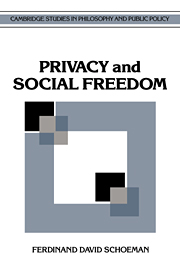Book contents
- Frontmatter
- Contents
- Acknowledgments
- Introduction
- 1 The meaning and scope of privacy
- 2 Mill's approach to social freedom
- 3 Articulated rationality and the Archimedean critique of culture
- 4 Social freedom from the perspective of cognitive and social psychology
- 5 The importance of cultural authority for morality
- 6 Explaining privacy's place
- 7 The ascent of privacy: a historical and conceptual account
- 8 Privacy and gossip
- 9 Privacy and spheres of life
- 10 Spheres of life: a literary exploration
- Epilogue
- Notes
- Index
Introduction
Published online by Cambridge University Press: 23 October 2009
- Frontmatter
- Contents
- Acknowledgments
- Introduction
- 1 The meaning and scope of privacy
- 2 Mill's approach to social freedom
- 3 Articulated rationality and the Archimedean critique of culture
- 4 Social freedom from the perspective of cognitive and social psychology
- 5 The importance of cultural authority for morality
- 6 Explaining privacy's place
- 7 The ascent of privacy: a historical and conceptual account
- 8 Privacy and gossip
- 9 Privacy and spheres of life
- 10 Spheres of life: a literary exploration
- Epilogue
- Notes
- Index
Summary
This book evolved from my effort to relate three areas of personal and professional interest: privacy, social freedom, and human social nature. First is privacy. When I began writing about privacy – at the time, I thought of it as writing about intimacy – I was convinced that there are central domains of human social and moral life that are ill-suited to being characterized by any of the standard competing moral and legal theories. In an early essay, I argued that properly understanding the moral dimensions of parent–child relationships requires us to recognize the limits of both utilitarian and rights-centered autonomy-promoting approaches. I still believe this.
My concern with privacy in this book is not focused primarily on the claims of privacy that can be made against governments. Rather, I aim to understand the dimensions of privacy that arise in our social encounters. I argue that privacy in the contexts of our social relations protects us from social overreaching – limits the control of others over our lives. Understanding how privacy works in the social context is more complicated than understanding how privacy works in the governmental context. One reason for this difference is that immunity from certain forms of social control typically is not a blanket prohibition directed against all others but is selectively directed. Appreciating this difference will provide some insight into the debate over whether so-called life-choice issues–issues of birth control, including abortion; sexual orientation; use of recreational drugs; and so forth–are properly categorized as autonomy or privacy issues.
- Type
- Chapter
- Information
- Privacy and Social Freedom , pp. 1 - 10Publisher: Cambridge University PressPrint publication year: 1992



